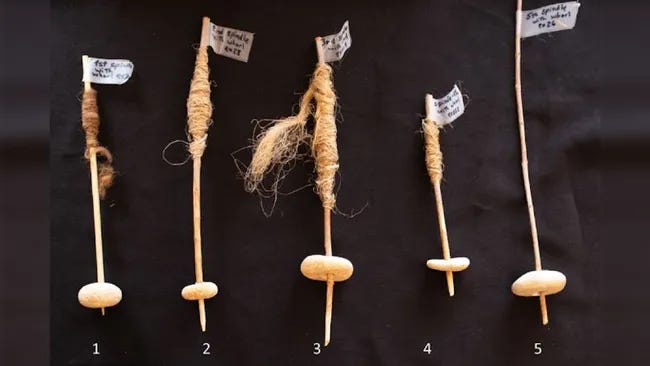🧐 Ancient Beat #134: King Arthur's Hall, unexpected relationships in Pompeii, and a very early "wheel"
Hi all, and welcome to issue #134 of Ancient Beat. Before we get started, a correction from last week.
There was an oversight in my summary of the bamboo wagon that was discovered in the Swiss Alps. Turns out it’s actually from the 20th century. I was way off! A couple of you kindly pointed this out so I edited the web version shortly after sending the email.
Really sorry about the fumble, folks!
Alright, here’s the latest ancient news. 👇
🗞 Ancient News: Top 5
New DNA Evidence Rewrites Long-Told Stories Of People In Ancient Pompeii — Recent DNA analysis of casts from Pompeii has challenged longstanding assumptions about the relationships and lives of its ancient inhabitants. Among the finds is evidence disproving the notion that individuals found together, such as a supposed mother and child or two embracing women, were related. DNA revealed that the "mother" in the former pair was actually a man, unrelated to the child, and that one of the “women” in the latter was also male. The study focused on casts in the “House of the Golden Bracelet,” where four individuals were discovered, none related, despite previous interpretations as a nuclear family. These findings reveal that Pompeii’s residents, primarily descended from eastern Mediterranean populations, had a more complex social and familial structure than previously thought. This research builds on earlier DNA studies from 2022, confirming Pompeii’s diverse heritage and the potential for further insights through ancient DNA, preserved by the unique conditions created by the eruption in 79 CE.
Cornish Monument “King Arthur’s Hall” Found To Be 4,000 Years Older and Without Parallel — Archaeologists have re-evaluated King Arthur’s Hall, a mysterious stone structure on Cornwall’s Bodmin Moor, determining it dates back to roughly 6000 BCE, far older than previously believed. The hall consists of a rectangular enclosure surrounded by upright stones, forming a unique layout with no known parallels in Britain. Initial assumptions dated the site to the medieval period, but recent excavations uncovered tools, ceramics, and charred plant remains suggesting early Neolithic activity. The purpose of King Arthur’s Hall remains unclear, though its alignment hints at possible ceremonial or astronomical significance. This discovery challenges current understandings of early British sites and suggests that Bodmin Moor was a focal point for cultural or ritual gatherings thousands of years earlier than thought.
12,000-Year-Old, Doughnut-Shaped Pebbles May Be Early Evidence of the Wheel — Archaeologists in Israel have discovered approximately 100 limestone pebbles, each weighing between 0.04 and 1.2 ounces, with central perforations, at the Nahal Ein Gev II site near the Sea of Galilee. Dating back around 12,000 years, these doughnut-shaped stones are believed to be spindle whorls — tools used in textile production to spin fibers like flax or wool. Experimental replicas of these pebbles effectively spun textiles, suggesting that early humans developed rotational tools long before the invention of the wheel around 6,000 years ago. This technology may have facilitated the production of materials like bags and fishing lines, marking a critical step in textile and storage technologies. The study concludes that these spindle whorls provided early rotational capability, potentially influencing later innovations such as the potter’s and cart wheels.
Site of Ancient, Key Battle in Iraq Found by Archeologists Using Spy Satellite Images — Archaeologists have identified the site of the 7th-century Battle of al-Qadisiyah in present-day Iraq using declassified 1970s U.S. spy satellite images. This pivotal battle, fought between Arab Muslims and the Sassanid Persian Empire, was crucial in the spread of Islam. The site, located approximately 20 miles south of Kufa in Iraq's Najaf province, features a distinctive trench and ancient fortresses that align with historical accounts. Pottery shards found at the location further confirm its period. Excavations are planned to commence in the coming year.
5,000-Year-Old Sacrificial Site Stuns Archaeologists in Sweden — Archaeologists in Skåne, Sweden, have uncovered a rare 5,000-year-old Neolithic sacrificial site with a unique stone walkway stretching approximately 160 feet in a semicircular shape with elongated pits up to 5 feet deep, some lined with stones and others containing pottery. This ceremonial complex, linked to the Funnelbeaker Culture (4300-2800 BCE) and located on the edge of an ancient wetland, was used for ritual gatherings where offerings were left. Artifacts found include pottery fragments, flint tools, wood items, and animal bones. Notable bone artifacts include an antler tool for flint work, a fishing hook, and a stylus for leatherworking, all remarkably well-preserved. The site, likely in use between 3500 and 3000 BCE, reveals evidence of feasts and ritual butchering, with offerings placed in the wetland and open pits within the site’s enclosure. Sites of this nature are extremely unusual for the period.
That’s it for the free Top 5! If you’re a free subscriber, sign up for the paid plan for another 20 discoveries and 5 recommended pieces of content covering why humans have extended childhoods, Denisovan contributions to our DNA, the Greek Dark Age, the spirit realm depicted on a cliff, and forgotten henges.
And if you don’t want to subscribe but you’d like to say thanks, here’s my Buy Me A Coffee link.
Until next time, thanks for joining me!
-James
Twitter: @jamesofthedrum
P.S. If you want access but it’s a little too steep for you right now, just email me — I want this to be accessible.
P.P.S. Paid members, read on!




